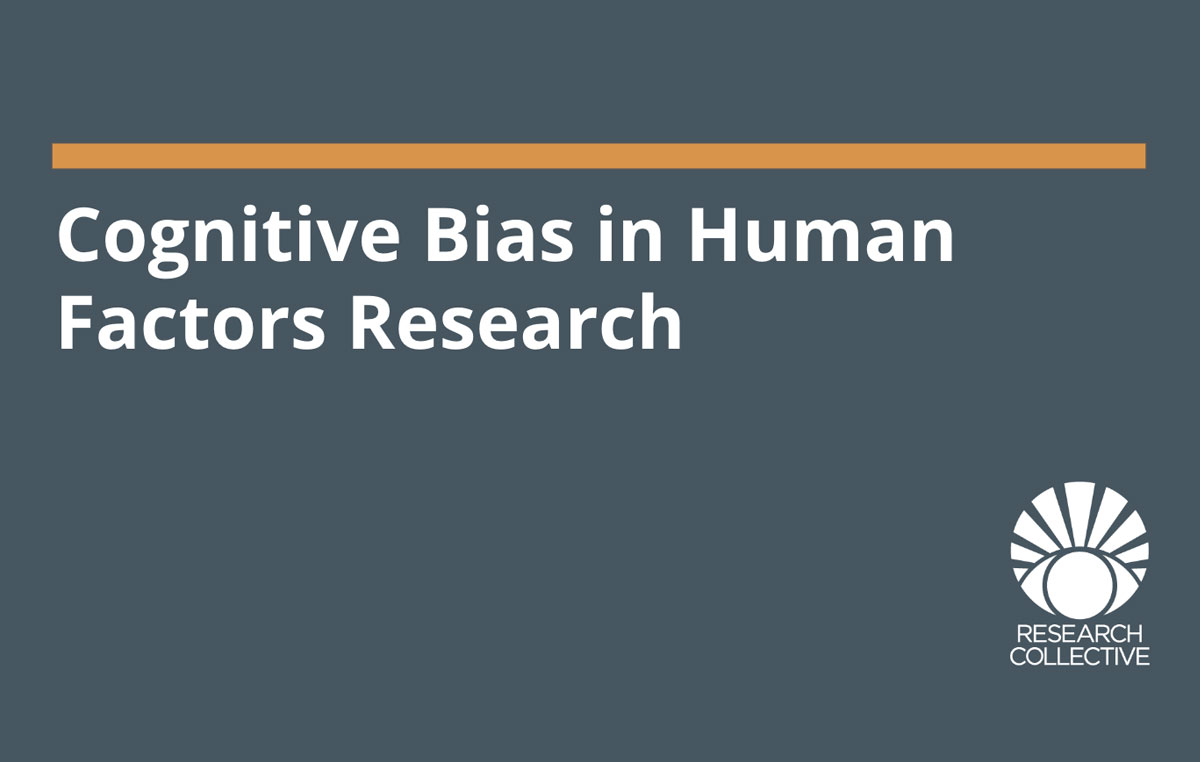Cognitive Biases
A cognitive bias is a pattern or tendency to have incorrect, distorted, or irrational judgments. Think of them as ‘blind spot’ or a ‘lens’ for how we view our environments. These biases can significantly alter human decision-making in a manner that is nearly always beyond awareness.
As human factors researchers, we often consider cognitive bias in the subjects we study. In a field that requires a deep understanding not only of how humans interact with the world but also of human cognition, biases can strongly impact a user’s experience. What many of us don’t consider, however, is our own predisposition to hold cognitive biases. We are not above cognitive biases ourselves, and the integrity of our research can suffer without constant effort to remain objective.
Overcoming bias starts with awareness. Below you will find a small collection of common biases that we, as researchers, designers, and product developers, are susceptible to. By understanding what they are and what can be done to counter them, the first steps can be taken toward objective human factors research.
Confirmation Bias
Confirmation bias is the inclination towards evidence that supports an existing belief or opinion. This is also known as “You see what you want to see”, and it can be detrimental to collecting quality data. You see, we have a natural predisposition to think we are right. Imagine that. So when ambiguous evidence surfaces, it’s safe to say that we will favor our own explanation and put less stock in others. There aren’t many practices that can cripple the high potential of human factors research more.
It is essential to be aware of this tendency. Of course, we think we are right. Naturally! But putting effort into considering other perspectives will prove beneficial.

Daniel Kahneman and Amos Tversky, are the pioneers in studying cognitive heuristics and biases. https://images.ecestaticos.com
Hindsight Bias
The hindsight bias provides further evidence that people can be confident to a fault. It is the notion that events are more predictable after the fact than before. An obvious thing to say for sure, but you’d be surprised at how easily this bias creeps into research. The hindsight bias can make people overestimate their knowledge and ability. This, in effect, makes them much less open to new ideas and creating a better product. The danger in human factors research is the confidence it brings out in people.
There are some infamous sayings related to hindsight: “I knew it all along” is a personal favorite; and you’ll hear that “hindsight has 20/20 vision” pretty frequently, too. Don’t let hindsight bias interfere with learning from your research. Researchers that feel “they knew it all along” won’t stop to explore why something truly happened.
Negativity Bias
Amongst stakeholders, negative findings in research typically carry more weight than positive ones. If eight people approve of a new label and two people criticize it, negativity bias suggests that we tend to focus and act on those two critiques. While there is certainly reason to investigate sources of negative feedback or user error, every finding can be valuable. We can learn just as much from a task completion as we can from a failed attempt.
The difference between positive and negative feedback is the fact that we don’t expect negative feedback. It surprises us, or else we would have done something about it! That’s why criticism gets so much attention. So, with that in mind, we can move forward with the expectation that we will receive both positive and negative feedback and can learn from both. Observe findings at face value.
Commitment Bias
We are inclined to make decisions to ‘fit’ the project’s current trajectory. This one is similar to confirmation bias, but rather than interpreting findings to fit our own theories, we do so to accommodate the project itself. “According to the data, users prefer Option B over Option A, but switching over to Option A will cost us 300 hours of work. It’s just too late to make the change.”
“It’s too late to make the change” is said far too often. The best way to offset commitment bias is through early, iterative human-centered design. If you iterate early enough, good ideas will rise to the surface. And the bad ones? They’ll get rejected, no harm, no foul. It’s much easier to make a change in the development stage than it is after release.
The IKEA Effect
The IKEA effect is the idea that we place a disproportionately high value on things we have made. Our projects are our babies. We love them, criticism hurts, and we just aren’t as open to receiving it. The unfortunate result is insulation from opinions that might be of tremendous value.
This is a problem because as the creators of some product, we are also the ones who will make changes. Ignoring or discounting feedback that we don’t agree with (or don’t want to hear) effectively negates the benefits of human factors research. Other people have good ideas and can greatly improve the product, it’s just a matter of listening.
Conclusion
More biases affect us every day, but these five are especially important to be aware of as we design for the user and conduct human factors research. The research and design practices we adhere to have been developed over many years of careful planning, testing, and discussion; they are a huge reason human-centered design has succeeded. Unfortunately, these carefully developed techniques are easily thwarted by our subjective tendencies.
To preserve robust practices, each time we engage in human factors research we must remain objective, check our egos at the door, and strive to better the product by any means necessary, even if our expectations are challenged. Just because we think one way does not necessarily mean everyone else shares the sentiment. The sooner each of us truly understands that the better off our products will be in the long run.
It all starts with identifying these convictions. From there, if we indeed have a theory explaining some phenomenon, we must do our homework to search for alternative explanations, even if we ‘know’ we are right. We must keep an open mind, observe findings at face value, and the human-centered design process will take care of everything else.




